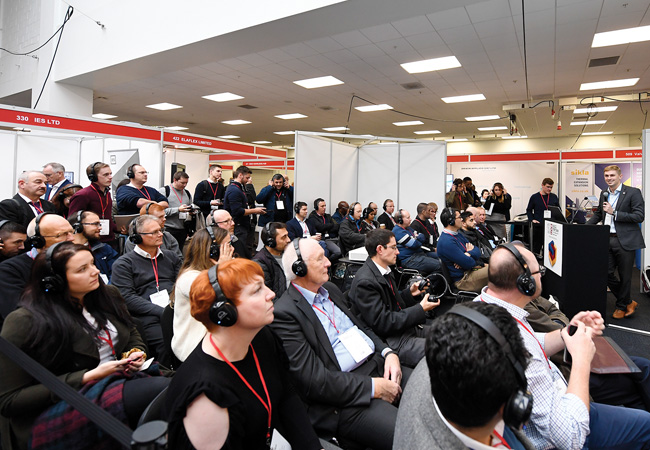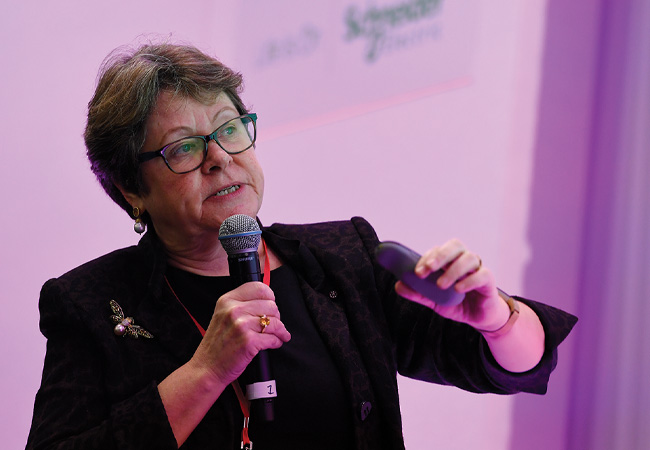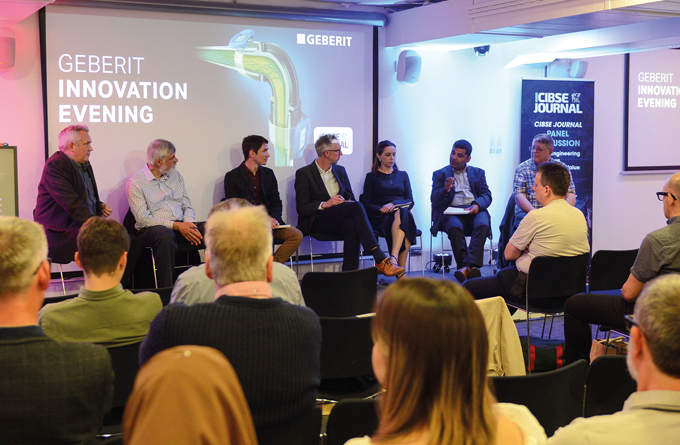
Delegates at Build2Perform Live
Attendees at the 5th CIBSE Build2Perform Live were given a two-day insight into the challenges facing the building services industry if it is to meet ambitious zero carbon targets.
A wide-ranging presentation by Lady Brown set the scene. The deputy chair of the Climate Change Committee (CCC) challenged the construction sector to match other sectors on reducing carbon emissions. She told a full auditorium that UK emissions from construction had only fallen by around 1-2% between 2013 and 2018, while power companies had cut CO2 by around 55%, and industry and waste firms by 11-12%. Brown also highlighted average temperature projections for 2100 from the UK Climate Predictions report for 2018. In a high-emissions scenario, there is a range of warming from 0.7°C to 4.2°C in winter, and 0.9°C to 5.4°C in summer.

Baroness Brown of Cambridge
Her presentation, Fit for the Future in a Changing Climate, focused on two strands of the work being done by the CCC: mitigation – what has to be done to reduce greenhouse gases –and adaptation, the actions needed to reduce the country’s vulnerability to climate change. Lady Brown explained that, while less rainfall in the UK was likely to lead to water shortages, demand could potentially still be met with adaptation measures, such as planting more trees, and building flood resilience and sustainable urban drainage.
For buildings to meet 2050 zero carbon targets, she said there would need to be a focus on efficiency in the next decade, plus the adoption of heat networks, heat pumps and hybrids. In the 2030s/40s, there would have to be widespread electrification and a potential switch to hydrogen in the gas grid.
The CCC has advised the government to look at hybrid solutions to reduce carbon emissions from the UK’s 29 million existing homes. Heat pumps could be used to provide the base load, with gas-fired technologies only employed for heating and hot water during peak demand periods. Lady Brown said this would allow more flexibility, with only an additional 40kW of electricity required for a home to power its heat pump.
There was intense interest in heat pumps across the show, including in the seminar by Lochinvar’s Scott Mason and the session on the specification, integration and whole-life impact of heat pumps, featuring Star Renewable Energy’s Dave Pearson and Elementa Consulting’s Louise Hamot.
Professor Will Swan, leader of the Applied Buildings and Energy Research Group at the University of Salford, spoke about research looking at integrating a heat pump and battery with electric vehicles at the university’s Energy House, a full-scale replica of a Victorian terrace home.
Historic retrofits
At the session on retrofitting and refurbishing historic, listed and rural buildings, Historic Scotland’s Moses Jenkins presented a case study of 120-year-old Holm Farm Cottage.
Maintaining moisture movement within the fabric of the traditionally constructed building was a key element in the retrofit, Jenkins said.
Within six months of a previous £18,000 retrofit, the building developed severe mould because the insulation was not permeable to moisture and pathways for air to move around had been sealed up. Jenkins said the old insulation was replaced with vapour-permeable material, sealed vents were opened up, and extract ventilation was incorporated.
‘We took account of the occupants of the building and how they lived, and the problems – and slugs – went away,’ he said.
Low carbon communities
There were many examples of engineers striving for zero carbon. Etude’s Chris Warboys spoke about the firm’s ambitious plan to decarbonise Bermuda’s electricity sector.
The Atlantic island’s electricity is mainly provided by gas turbines, and the network is run by one private utility company. When asked by the regulator to submit an energy plan, Etude proposed an ambitious scheme to have 65% renewable energy by 2040, including solar PV technology and an onshore wind farm coming online in 2025. ‘We had a small budget, so focused on the assumptions and methodology, and were transparent in how we did our calculations,’ said Warboys.

CPA’s Peter Caplehorn: ‘We need to focus on the compliance of the workforce
Etude engaged with the public through pamphlets, radio shows and the local media, and met critics. After receiving nearly 900 responses to the consultation, the regulator accepted most of its proposals, and set an even higher 85% renewable energy target by 2045.
Another initiative that engaged closely with the public was the Cornwall Energy Island Project, set up by BuroHappold Engineering in partnership with the Eden Project. Ben Smallwood explained how BuroHappold held a workshop in 2015, at which local people explored the future of Cornwall’s energy landscape. This was followed by sessions in 2017 and 2019, which aimed to ‘enthuse, educate, energise and empower’. ‘Energy games’ enabled people to consider reduction in demand and an increase in renewable supply.
There was general agreement to reduce demand by about 50% and increase supply to exceed 2030 demand by 30%, leading to a net-export opportunity. Since then, Cornwall has secured a devolution deal with specific mention of low carbon energy, and the council has set ambitious energy targets for 2030. ‘Structured events are a powerful way of centralising action,’ said Smallwood.
Thomas Lefevre, of Etude, spoke about the zero carbon roadmap for the London Borough of Tower Hamlets, which has a 2030 net-zero target. ‘We have to break up radical targets into smaller radical targets that can be achieved in the short term,’ he said.
At the session on resilience of schools to climate change, Faithful+Gould’s Tim Taylor said the performance of 11 schools was modelled in April – following BB101 overheating methodology – using the 2°C and 4°C global warming scenarios. They found that ‘schools designed today are going to struggle with a warming of two degrees, and even more so with four degrees’.
In another study, using Department for Education building in-use surveys of 70 schools over three years, it was found that they used twice as much energy as predicted, said Joe Jack Williams, of Feilden Clegg Bradley Studios. However, environmental – rather than energy – data was difficult to obtain because the schools didn’t want to share it for liability and PR reasons.
BPN calls for regulation of building operation
On the second day of Build2Perform, the Building Performance Network (BPN) – managed by CIBSE – launched a statement jointly signed by the Riba, UK Green Building Council, Good Homes Alliance, London Energy Transformation Initiative (Leti) and CIBSE.
The statement highlights that voluntary industry initiatives are not delivering the pace and scale of change required for building performance to improve and for the built environment to contribute to the UK’s net-zero emissions target.
It therefore called for:
- Operational building performance to be subject to regulatory requirements. This should start with energy and carbon, and be followed by other aspects, such as air quality and comfort
- The public sector to adopt operational performance requirements
- Government to require building performance disclosure, and to support the necessary infrastructure for this to happen.
The launch was followed, in the evening, by a presentation to the first gathering of Architects Declare – 300 architects who have pledged to act to reduce carbon emissions and improve building performance.
The statement is now open for other individuals and organisations to sign in support. View the full statement and supporting background here.
The BPN is keen to hear from organisations that would be willing to voluntarily disclose the energy consumption of their premises, to help build momentum and demonstrate the industry’s commitment to improving building performance.
If you would like to add your name to the supporting signatories and/or discuss disclosing the performance of your premises, contact laura@building-performance.network
Digital trailblazers
The Society of Digital Engineering Awards and Building Simulation Awards were announced at Build2Perform. They showed how technology can be harnessed to create accurate building models quickly, which can be used during a building’s lifetime to ensure environmental targets are on track.
The winners are pioneers, and there are fantastic examples of digital models of buildings being used as real-life models – such as Newcastle University’s Urban Sciences Building Centre, which multiple winner BuroHappold Engineering helped design.

Dan Cash: ‘IoT is in a trough of disillusionment'
A more downbeat assessment of the industry’s practical use of digital technology was made by Thayla Zomer, a researcher at the Centre of Digital Britain. ‘Evidence shows that BIM is not yet business as usual,’ she said, referring to a NBS 2019 Survey that revealed 40% of respondents who said they had adopted BIM weren’t actually using standards essential for BIM.
There was a decoupling of policy and practice, Zomer added, with an overemphasis on technology by academia and not enough focus on the change in processes required to implement BIM. ‘Adoption needed to be motivated by legitimate reasons rather than technology,’ she said.
In the same session, Dan Cash, senior lecturer at the University of the West of England, spoke about how the Internet of Things (IoT) is struggling to be implemented in buildings. Expectations for the technology had been over-inflated, he said, and IoT was currently in a ‘trough of disillusionment’. He quoted a report by Cisco, which found that 60% of IoT initiatives stall at proof-of-concept stage. Cash said it should be used to optimise building systems, and that automated seasonal commissioning offered an opportunity to improve building performance.
He showed an example of how IoT could be achieved, at a demonstration project by Atamate in Cardiff. Six new, insulated flats had all-electric building services installed, with one featuring occupancy-based heating and ventilation. Sensors communicated with the building’s local hub. This connected to the cloud, where algorithms are being developed to optimise and maintain services. Energy demand for the flat with occupancy sensors was 11.7kWh.m-2 per year and Cash claimed the capital costs were below average.
‘We need to get to a process of continually collecting data so buildings can perceive changes [in the environment] and carry out actions to improve performance,’ he said.
Zero incident, defect and waste
At the session on offsite construction, ‘Is zero incident, defect and waste possible?’, Dale Perini, of Bryden Wood Technology, spoke about the GlaxoSmithKline (GSK) ‘Beta’ building prototype – a pharmaceutical facility that can be built to international standards anywhere in the world, using local skilled labour. The Ikea-inspired ‘factory in a box’ – produced in response to GSK’s need to develop factories and packaging facilities in Africa and Asia – fits into a shipping container, and comprises a simple set of instructions and made-to-measure components.
Perini said eight former Gurkhas, unskilled in construction, built a defect-free pharmaceuticals facility from components delivered in shipping containers, packed in reverse order for the re-assembly process, in 12 weeks, resulting in a 60% reduction in programme and 70% reduction in labour compared with a standard build project.
David Bradley, of E+I Engineering Group, said offsite manufacture cuts out time on site, as equipment is tested and commissioned in the factory and does not need to be tested again. To ensure their electrical rooms and skids – which are pre-cabled – can be delivered on lorries, he said the switch gear has been narrowed to ensure no road closures for wide loads are needed. The equipment within the units has also been equally balanced, to allow easier lifting by crane.
There are social benefits too, said Lewis Jones, of Prism. Its manufacturing facility is not a construction site, so workers – who have four-day weeks – spend less time travelling and looking for accommodation. ‘This cuts emissions associated with travel, and power to keep things on,’ he said.
Creating a competent workforce
In the session on competence in a post-Hackitt world, Society of Façade Engineering vice-chair Graham Dodd, of Arup – who was on the engineers working panel looking at competency after Grenfell – said it is ‘not simply what I’m obliged to do contractually, but what is required of me as a professional engineer to make sure the building works as a system and is safe’.

Society of Façade Engineering vice-chair Graham Dodd
Construction Products Association’s Peter Caplehorn said there had been a slow decreasing of standards, and deregulation, in the industry, over the past 50 years. Dame Judith Hackitt’s review found the regulations and systems supporting them were not fit for purpose, he said. ‘We need a culture change, and to focus on the compliance of the workforce.’
To ensure industry delivers on performance, Caplehorn added ‘a new form of contract is needed – away from design and build – and a way of procuring that’s not about least cost’. Collective responsibility and ownership are also vital. ‘We need to run back the confidence that was lost [in the construction industry] and build buildings that are safe, and proven to be safe – and that is a no-brainer,’ he said.
A question of integrity
A panel discussion on integrity between CIBSE Fellows and YEN Members resulted in a positive debate on the ethics of engineering.
Marian Ferguson, founding director at Energylab Consulting, said: ‘We need to be better storytellers and focus on what matters to the people using buildings. Engineers need to be true problem-solvers rather than regulatory box-tickers, she added.
Alexandra Logan, senior mechanical engineer at ChapmanBDSP, agreed there needed to be more onus on the human side of engineering. She said collaborating with others is what makes buildings come alive, and that being aware and conscientious is what makes a good engineer. ‘The human element within design is so important.’
Tadj Oreszczyn, professor of energy and environment at University College London, said engineers had to have the confidence with issues. The industry was ‘not very good at reporting failures or near misses’, he said, while noting that many other industries were excellent in this area.
Ideas emerging from the debate were reverse mentoring for Fellows and YEN, stronger mechanisms for CIBSE to ask what Members want, and a media outlet for YEN views.


